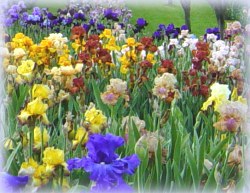
WHEN TO PLANT:
The best time is generally July through September. Early planting establishes plants before winter. Planting of new rhizomes should be done as soon as possible after receiving them. If unable to do so, store in a cool dry place and keep them free of insects. Rhizomes can stay out of the ground a week or two if necessary.
 WHERE TO PLANT:
WHERE TO PLANT:
A sunny, well drained location with at least a half day of sun. Plant the rhizome with the top just below the surface of the soil and make sure not to have any air pockets around the roots. Any good neutral garden soil will grow iris. Distance apart should be 18"-24".
FERTILIZER:
Do not use heavy nitrogenous fertilizer and do not overdo the fertilizing. Heavy fertilizing promotes soft growth that is apt to rot. In the preparation of your new iris bed, spade in a good application of compost below the roots. Well processed compost is ideal. A light application of a well balanced fertilizer applied as a top dressing dusted around and in between the plants a month after bloom and in early spring or very late fall is desirable. Steamed bone meal or super phosphate are fine top dressing materials. It is easy to overdo fertilizing, but undesirable to omit feeding entirely.
WATERING:
To help newly set plants get their root systems established, they should be kept consistently moist but never soggy. Established plants can tolerate some drought in mid-summer (a period of semi-dormancy). Let the soil dry out to a depth of 1" - 2" between waterings.
 GROOMING:
GROOMING:
It is not recommended that green iris leaves be cut back since plant food is stored there. However, old or diseased leaves should be removed. Old flower stalks should be cut off next to the rhizome. Keep your iris free of weeds.
TRANSPLANTING:
Irises should be divided every 2-4 years depending on how crowded the clump is. Dig the entire clump out of the ground with a spading fork or shovel. Shake or wash soil off the roots. Trim green leaves into a fan shape about 6" long. Cut off healthy rhizomes with leaves. Discard all rhizomes without leaves. The newly planted rhizomes should be kept moist, not wet, until new roots can get established and the plant is sending up new leaves.
